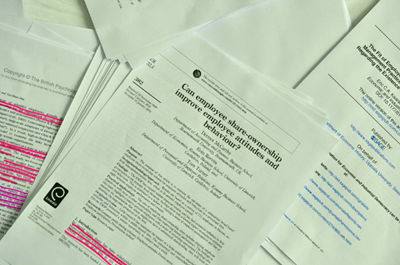美国dissertation写作结构中包含的10个要点解析
发表时间:2016-08-16 11:01:34 作者:admin 阅读:122次

当你完成了你的实验研究计划后,最艰巨的dissertation写作即将开始,在开始之前,你需要准备一个完美的论文计划,不仅要在于展示你清晰的论文机构,还在于显示你工作的关键以及最好的效果展示,进行写作的过程中,通过以下有效的结构构建方法,您将可以快速而清晰的构建自己的dissertation,我们一起来看看美国dissertation写作结构中包含的10个要点解析!如果您需要代写美国dissertation,欢迎联系我们在线客服:800056654
When you have completed your research and planning the most daunting step of all can be the actual process of preparing to write up your masters dissertation. Before you begin to write, it is very important to plan a strong dissertation structure.
This will help in two ways; firstly, a clear dissertation structure is key to demonstrate and display your work to the best possible effect, and secondly it will help you to have a clear structure when you come to write up your research, making the actual writing process much easier as you will effectively simply be following the ‘map’ your structure will lay out for you.
Top structure tips
1. Problem. The methodology typically follows your literature review, so for the purposes of clarity and regaining focus it is useful briefly to recap the research aim, objectives, and questions of your dissertation. Define and explain the problems which you seek to address in a succinct manner.
2. Approach. Give an overview of your approach to primary research in order to guide the reader and contextualise your methodology. By identifying all methodological aspects to which you will attend – i.e. rationale, justification, sampling issues, etc. – you can signal unambiguously to the reader that you fully understand the importance of a thorough, astute methodology.
3. Reproducibility. The ability to reproduce the results of an experiment is a hallmark of proper scientific method, and is of equal importance in humanities, as reproducibility indicates greater credibility and usefulness. Provide a detailed description of your techniques, such that those wishing to challenge your position could, if they wished, reproduce the same research.
4. Precedence. Consider whether your research methodology is typical of comparable research projects within your particular subject area. A review of the relevant literature will doubtless uncover comparable published research, in which case the adoption of those methodologies may lend authority to your approach. Alternatively, one of the gaps you have identified in current research may be that there is a tendency towards a particular methodology. No methodology is perfect, in the sense that whichever method one employs, it will inevitably have weaknesses. By highlighting, for instance, that the majority of previous studies have used a positivist approach, you might argue that the research area as a whole would be strengthened by the application of an interpretivist, qualitative line of enquiry. This strengthens your own methodological approach, while adding critical academic rigour to your dissertation.
5. Justification. It is absolutely essential that you provide sound reasons for the methods you have chosen to conduct your research. This aspect is particularly important when adopting a novel or non-standard methodology; approaches at odds with comparable endeavours require considerable and rigorous justification. However, they can also be a source of strength as you are adding breadth and depth to current research by utilising a novel methodological approach. At this point you might have noticed a bit of a theme – whether you follow the methodological hegemony in your area of study or go against it, you have to build a strong argument to support your approach. Being able to show the reader that you fully understand the philosophical and methodological choices you have made tells them that your research is well grounded.
6. Rationale. No matter what type of research you engage in, there is almost always a number of methodological approaches available. In your rationale, critically evaluate alternate approaches in order to defend the methods you have finally chosen. Weigh up the pros and cons of all relevant alternatives, including your own choice. This should start with your philosophical predisposition – i.e. are you a positivist, interpretivist? – all the way down to the level of the research tools you will be using. For instance, if conducting interviews, will they be structured, semi-structured, or unstructured? What is the difference between these approaches, and what makes one more suitable for your research?
7. Reliability and validity. Essential considerations in all types of research, issues of reliability and validity must be explicitly discussed. Many matters fall under this area, including accuracy, precision, sources of error and statistical significance. However – if you are conducting qualitative research, one might argue that the transferability, repeatability, and generalisability of your findings is more important. That is because reliability and validity are quantitative terms – and generating qualitative findings that meets the rigid quantitative demands of reliability and validity in a scientific sense would be a Herculean task. However, you still need to discuss this if you opt to follow a qualitative methodology.
8. Sampling. Questions concerning sampling techniques and sample size can be considered under reliability and validity, but are often important enough to be given special attention. If following a quantitative methodology, the impact of sample size upon the statistical significance of your results is an issue of such importance that you should be mindful of this when designing and writing up your methodology. As you know, the aim of qualitative research is not to generate findings of statistical significance, but that doesn’t mean that sampling isn’t important. Qualitative research could have a sample of anything from 1 to 100, or even more (though that is rather rare – and for dissertation methodologies one would usually expect 1-10). What is important in a qualitative study is that you sample has a high degree of relevance.
9. Brevity. Keep your methodology chapter focussed and lucidly written by appending indirectly relevant material to the end of your dissertation writing. Copies of questionnaires and other methodological material should usually be placed in the appendix. Another good way of keeping your methodology chapter concise, while simultaneously giving your marker an overview of your approach, is to make use of tables when comparing different approaches and their relative strengths and weaknesses.
10. Generalisation. Include a section in your methodology which directly addresses the question of how far data obtained through your approach can be generalised. Bear this issue in mind when designing your methodology too, as results with general significance outside of your direct data set will tend to increase the persuasiveness of your eventual findings. If utilising a qualitative methodology, you might instead focus on the extent to which your findings can be transferred to other contexts, and the value provided in terms of understanding the issue at hand in greater depth.
通过以上dissertation结构介绍,一个完美的dissertation写作不仅包含你需要有待解决的问题、研究的合理理由、进行研究的方法、抽样调查、可信度分析、还有你的概括部分都是不能少的。所以一篇dissertation涉及的知识面是很广的,Meeloun为您提供常规的dissertation写作指导、留学生dissertation代写服务,联系客服QQ:800056654



